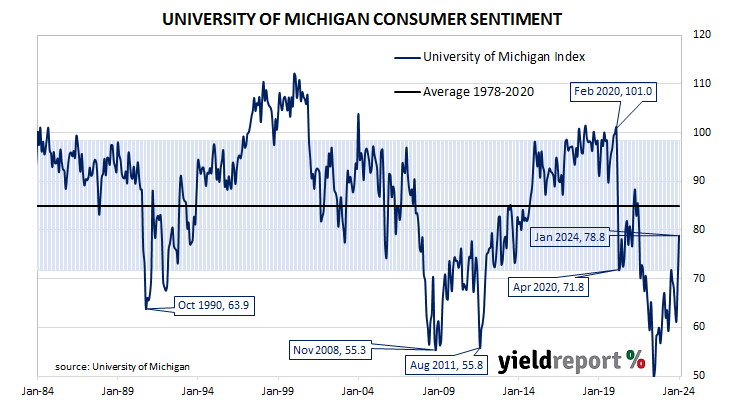Summary: University of Michigan consumer confidence index jumps in January, reading markedly more than expected; views of present conditions, future conditions both improved; reading supported by confidence regarding inflation, strengthening income expectations; short-term Treasury yields rise, longer-term yields either steady or down; 2024 rate-cut expectations soften; ANZ: US recession never started when consumer confidence trending up.
US consumer confidence started 2020 at an elevated level but, after a few months, surveys began to reflect a growing unease with the global spread of COVID-19 and its reach into the US. Household confidence plunged in April 2020 and then recovered in a haphazard fashion, generally fluctuating at below-average levels according to the University of Michigan. The University’s measure of confidence had recovered back to the long-term average by April 2021 but then it plunged again in the September quarter and remained at historically low levels through 2022 and 2023.
The latest survey conducted by the University indicates confidence among US households has improved markedly for a second consecutive month. The preliminary reading of the Index of Consumer Sentiment registered 78.8 in January, considerably more than the 70.0 which had been generally expected as well as December’s final figure of 69.7.
Consumers’ views of current conditions and their views of future conditions both improved relative to those held at the time of the December survey.
“Consumer views were supported by confidence that inflation has turned a corner and strengthening income expectations,” said the University’s Surveys of Consumers Director Joanne Hsu. “Like December, there was a broad consensus of improved sentiment across age, income, education, and geography.”
Short-term US Treasury bond yields rose on the day while longer-term yields either remained steady or declined. By the close of business, the 2-year Treasury yield had gained 5bps to 4.40%, the 10-year yield had returned to its starting point at 4.14% while the 30-year yield finished 2bps lower at 4.35%.
In terms of US Fed policy, expectations of a lower federal funds rate in the next 12 months softened while still factoring in several cuts. At the close of business, contracts implied the effective federal funds rate would average 5.325% in February, in line with the current spot rate, 5.285% in March and 5.21% in April. January 2025 contracts implied 4.00%, 133bps less than the current rate.
“Since the series began in 1952, a recession has never started when consumer confidence is trending up,” ANZ FX analyst Felix Ryan observed.
It was once thought less-confident households are generally inclined to spend less and save more; some decline in household spending could be expected to follow. However, recent research suggests the correlation between household confidence and retail spending is quite weak.


